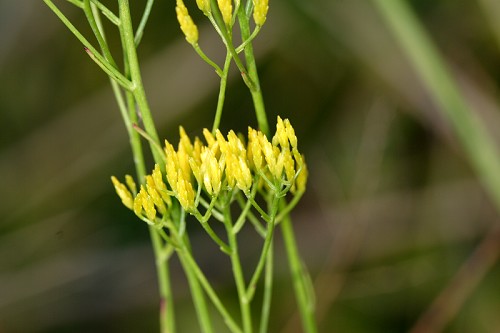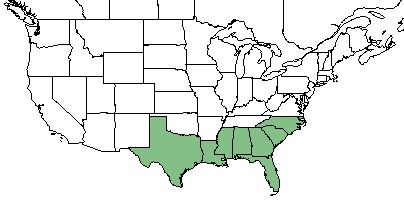Difference between revisions of "Bigelowia nudata"
| Line 31: | Line 31: | ||
==Ecology== | ==Ecology== | ||
===Habitat=== <!--Natural communities, human disturbed habitats, topography, hydrology, soils, light, fire regime requirements for removal of competition, etc.--> | ===Habitat=== <!--Natural communities, human disturbed habitats, topography, hydrology, soils, light, fire regime requirements for removal of competition, etc.--> | ||
| − | ''B. nudata'' can be found in moist sandy loams of savannahs, pine barrens, and margins of swamps as well as rich sandy soils in wet prairies and open pinelands <ref name= "Loran"/>. It is a wide-ranging species, mainly occurring in wet to mesic habitats <ref name= "Loran2"> Anderson, L. C. (1977). "Studies on Bigelowia (Asteraceae). III. Cytotaxonomy and Biogeography." Systematic Botany 2(3): 209-218. </ref>. | + | ''B. nudata'' can be found in moist sandy loams of savannahs, pine barrens, and margins of swamps as well as rich sandy soils in wet prairies and open pinelands <ref name= "Loran"/>. It is a wide-ranging species, mainly occurring in wet to mesic habitats <ref name= "Loran2"> Anderson, L. C. (1977). "Studies on Bigelowia (Asteraceae). III. Cytotaxonomy and Biogeography." Systematic Botany 2(3): 209-218. </ref>. It can be found in disturbed sites such as front lawns and roadsides, while native habitats range from white-top pitcher plant prairies, wet pine flatwoods and cypress depressions, marsh edges, sandy scrub, dry sandy loams, and other moist areas. <ref name= "Herbarium"> Florida State University Robert K. Godfrey Herbarium database. URL: http://herbarium.bio.fsu.edu. Last accessed: June 2018. Collectors: Cecil R. Slaughter, Loran C. Anderson, Ann F. Johnson, S. W. Leonard, John B. Nelson, Bruce Hansen, JoAnn Hansen, R. K. Godfrey, L. Baltzell, R. A. Norris, R. Komarek, Lisa Keppner, Wade Biltoft, Steve L. Orzell, Edwin L. Bridges, Richard Carter, Olga Lakela, R. Kral, James D. Ray, Jr., George R. Cooley, R. J. Eaton, Sidney McDaniel, D. B. Ward, E. S. Ford, Erdman West, Paul L. Redfeam, Jr., R. R. Smith, Robert L. Lazor, M. Darst, and T. Myint. States and counties: Florida: Putnam, Walton, Franklin, Jackson, Bay, Volusia, Okaloosa, Flagler, Escambia, Santa Rosa, Wakulla, Calhoun, Liberty, Washington, Martin, Lee, Collier, Orange, Okeechobee, Osceola, Pinellas, Sumter, Pasco, Hillsborough, Sarasota, Palm Beach, Leon, Alachua, Nassau, Jefferson, and Bay. Georgia: Thomas. South Carolina: Berkeley. |
Associated species - ''Linum macrocarpum'' C. M. Rogers, ''Lophiola aurea'' Ker Gawl., ''Sarracenia alata'' Alph. Wood, ''Lachnocaulon digynum'' Koern., ''Magnolia virginiana'' L., and ''Scleria baldwinii'' (Torr.) Steud. <ref name= "Reid"> Reid, C. S. and P. L. Faulkner (2010). "Louisiana." Castanea 75(1): 138-140. </ref>. | Associated species - ''Linum macrocarpum'' C. M. Rogers, ''Lophiola aurea'' Ker Gawl., ''Sarracenia alata'' Alph. Wood, ''Lachnocaulon digynum'' Koern., ''Magnolia virginiana'' L., and ''Scleria baldwinii'' (Torr.) Steud. <ref name= "Reid"> Reid, C. S. and P. L. Faulkner (2010). "Louisiana." Castanea 75(1): 138-140. </ref>. | ||
Revision as of 18:38, 12 June 2018
| Bigelowia nudata | |
|---|---|

| |
| Photo from the Southeastern Flora Plant Database | |
| Scientific classification | |
| Kingdom: | Plantae |
| Division: | Magnoliophyta - Flowering plants |
| Class: | Magnoliopsida - Dicots |
| Order: | Asterales |
| Family: | Asteraceae |
| Genus: | Bigelowia |
| Species: | B. nudata |
| Binomial name | |
| Bigelowia nudata (Michx.) | |

| |
| Natural range of Bigelowia nudata from USDA NRCS Plants Database. | |
Contents
Taxonomic Notes
Synonyms: Chondrophora nudata
Varieties: Bigelowia nudata var. australis, Bigelowia nudata var. nudata
Description
B. nudata, also known as the pineland rayless goldenrod, is a native perennial forb that is a member of the Asteraceae family [1]. The species also consists of rhizomes which it uses to propogate [2].
Distribution
B. nudata is found in the Southeast United States, ranging from Texas to North Carolina [1]. However, it is most frequent along the coast lines of lower Mississippi to North Carolina [2].
Ecology
Habitat
B. nudata can be found in moist sandy loams of savannahs, pine barrens, and margins of swamps as well as rich sandy soils in wet prairies and open pinelands [2]. It is a wide-ranging species, mainly occurring in wet to mesic habitats [3]. It can be found in disturbed sites such as front lawns and roadsides, while native habitats range from white-top pitcher plant prairies, wet pine flatwoods and cypress depressions, marsh edges, sandy scrub, dry sandy loams, and other moist areas. Cite error: Closing </ref> missing for <ref> tag.
Phenology
It flowers twice a year, in the spring as well as the fall ranging from October to May [2].
Conservation and Management
Cultivation and restoration
Photo Gallery
References and notes
- ↑ 1.0 1.1 USDA Plants Database URL: https://plants.usda.gov/core/profile?symbol=BINU
- ↑ 2.0 2.1 2.2 2.3 Anderson, L. C. (1970). "Studies on Bigelowia (Asteraceae, Compositae). 1. Morphology and Taxonomy." Sida 3(7): 451-465.
- ↑ Anderson, L. C. (1977). "Studies on Bigelowia (Asteraceae). III. Cytotaxonomy and Biogeography." Systematic Botany 2(3): 209-218.